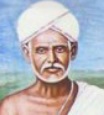
COMPOSER Sant Shishunala Sharifa |
|
|||||||||||||
|
Santa Shishunala Sharifa was born on 7 March 1819 in Shishuvinahala, a village in Shigganvi (now Shiggaon) taluk (in Haveri district), Karnataka. He was the son of an Imam Saheb, who was a disciple of Hajaresha Qadri, whose dream it was to unite Hinduism I and Islam. Hajaresha Qadri used to give “Linga Deeksha”, or initiation by tying a linga around the neck of a disciple, as per the Hindu Lingayat tradition. His father used to teach him Ramayana, Mahabharata, and even the teachings of Allama Prabhu. Legend has it that Shishunala Sharifa was conceived with the blessings of Basavanna.
Even when Shishunala was a boy, He was taught the tenets of both religions. In his birthplace Shishuvinahala, even today, both Hindus and Muslims revere him as a saint at the same temple.
Govinda Bhatta, a Brahmin, was famous in the region as an unconventional Master. He cared little for caste or religion, and spent more time with anyone who invited him, and ate anywhere he felt like eating. Other Brahmins could not stomach his way of life. One day, Govinda Bhatta came to Shishuvinahala, and Sharifa’s father found Him seated under a tree. He asked Him to accept His son as disciple. In front of the father, Govinda Bhatta called the young boy and said, “Hey Sharifa, who is your father?” The villagers laughed, but were shocked when the boy brashly said, “What kind of question are you asking? Your father and mine are the same!”. Govinda Bhatta laughed, patted the boy on the back and said, “Excellent, Sharifa! The land is fertile, the seed will sprout well. O Imam, leave Him to my care! From today, He is my son!” Sharifa followed Govinda Bhatta back to His village. The boy was found to be curious about matters beyond logic and the world, and about the secrets of creation. These qualities were nurtured by Govinda Bhatta. Society was surprised by their closeness. In the eyes of Muslims, the Master was a Kaafir (infidel) and for Brahmins, the boy was a Mleccha(outsider).
One day, Govinda Bhatta called all His young disciples to follow Him to the Temple. On the way, they were blocked by a thorn bush. Govinda Bhatta stepped on the bush with His slippers and climbed to the other side. The disciples, however, were bare-footed. Govinda Bhatta tossed His slippers across to them, but they hesitated. “A Master’s Padukas must be kept on the head, not worn on the feet”, they said. Bhatta looked at Sharifa, and said, “Will you at least join me?” Sharifa, without hesitation, puts on the slippers and crosses over. The two of them leave the others behind and go to the temple alone.
One day, Govinda Bhatta was seated with some Brahmins at the village crossroad. Just then, Sharifa comes by. The Master calls Him to sit, and the two sit very closely. The others were offended, and say, “Does that Muslim look like a Brahmin to you? You have no sense of cleanliness or social status!” Bhatta laughs, saying, “Just because you are born a Brahmin, do you think you’ll become one? None of you is a greater Brahmin than this boy!”. He takes off His sacred thread puts it around Sharifa, embracing Him tightly. Sharifa, overcome with feeling, prostrates himself at the Master’s feet. The Brahmins were highly offended.
One day, a Mullah asks Sharifa, “So, I see you’ve stopped coming to the mosque! Do you even remember what Namaz is?” To this, Sharifa calmly replies, pointing at His own body, “I dwell in this mosque, so why go and come? I am in constant worship of “I AM”, so what can be greater Namaz?” The Mullah was dumbstruck.
One day, Govinda Bhatta was sick and vomited. Then he turned to Sharifa and asked "Keep this vomit so no man steps on it". Sharif thought that the place where no one should step on it, he understands mythology behind the Govind Bhatta words so it is said that Sharifa drank it.
Sharifa’s parents force Him to marry. Sharifa goes to Bhatta and asks, “If I become a Samsari, won’t i get stuck in desire and illusion?” The Master replies, “Why are you worried? Even in the worst rain, does wind become wet? Does light become soaked? So go and get married!”
Sharifa married, and had a daughter. He joins work as a schoolmaster in Karadagi, to support the family. However, His wife passes away shortly. Sharifa’s neighbours adopt the child, and Sharifa quits His job. He starts participating in folk dramas, teaching simple lessons through daily experiences. Sharifa went through extreme poverty, often going without meals. However, Govinda Bhatta stood by Him through all His troubles.
After Govinda Bhatta left His body, Sharifa lived on for another twenty years. When He started falling ill and realised His days were few, He decided to give up His body according to “Sharana” tradition, in which ash is smeared on the body, and the feet of a Jangama, or Shaivite monk, are worshipped. The monk’s feet are then placed on the head, and life is given up. Nobody agreed, but on His insistence, a Jangama by name Hirematta Karibasavayya agreed. Shishunala Sharifa left His body on 3rd July 1889 AD.
The people were left confused. Sharifa was born a Muslim but lived with Hindu. The leaders of both communities came together and agreed to perform the last rites as per both religions. The Quran was read simultaneously with the Hindu Mantras.
A Samadhisthan was constructed in Shishuvinahala, in a vast compound. There, statues of both Govinda Bhatta and Sharifa are visited by both Hindus and Muslims, to this day. Shishunala Sharifa is known as the Kabir of Karnataka.
|
||||||||||||||




